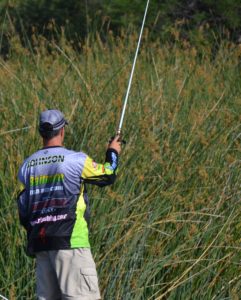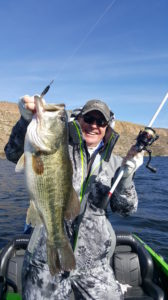Choosing the Right Fishing Rod
By Ron Johnson
 Deciding on what fishing rod to choose can be a daunting task and an overwhelming experience at first. Fishing rods come in all lengths, models, and styles with different benefits to help your pursuit of a chosen species. If you take a set of golf clubs, for instance, each is designed with different lengths, grip, action, and weight to help maximize the best shot on the course. Finding the right fishing rod for you is just as important.
Deciding on what fishing rod to choose can be a daunting task and an overwhelming experience at first. Fishing rods come in all lengths, models, and styles with different benefits to help your pursuit of a chosen species. If you take a set of golf clubs, for instance, each is designed with different lengths, grip, action, and weight to help maximize the best shot on the course. Finding the right fishing rod for you is just as important.
Before you head to the store to make your fishing rod purchase, decide on the species you are after and how often you plan to fish. Fishing rods are available in many models and vary in price. If you only plan on fishing one to two times per year, you may not necessarily be looking to spend a lot of money on a rod that would last long-term. However, understand that you will sacrifice quality and performance. If you are a more experienced or seasoned angler, you will appreciate and feel the differences of the higher quality fishing rods which are designed to hold up and last longer.
Below are a few things to consider when trying to find out how to choose a fishing rod.
Length
Fishing rods come in many sizes that can vary from four feet to nine feet long. This is measured from the tip of the rod to the butt of the rod. There are several things to consider when picking the length:
- Location of where you are fishing
- Whether you are fishing from shore (where you have a smaller area for casting)
- Whether it needs to break down for easy storage
- If you are you casting or trolling
Action
Just as important, the action of a rod can vary from Ultra-Light to Extra-Heavy. The last 1/2 to 1/3 toward the tip of a fishing rod will be your action. Heavy action will mean a stiffer tip, and fast action will be a softer more giving tip. The “Power” of a Rod or Backbone will be the mid- to lower portion of a rod. You will typically want a higher “Power” in your rod for bigger fish or heavier lures.
Weight of Lure
Most rods are marked with a weight that indicates its strength. Some categories include ultra-light, medium, extra heavy, and everywhere in between. Each category will have a different lure weight range. For example, heavy action rods have a range of 1 oz or more. If you are unsure of what would be best for you, always be sure to ask the experts where you are purchasing.
Rod
Make sure you’re choosing the right rod for the fishing reel you will be using.
- The most common fishing rods will be baitcasting and spinning rods. Most spinning rods are designed for finesse fishing and to cast lighter lures. The spinning reel/rod set up is also much easier to cast and very popular among beginning anglers.

- Baitcasting reel/rod set up will handle a larger range of fishing applications and lures. This is a preferred method for advanced anglers, and the spectrum of lures and techniques is much greater. When in pursuit of bass or other large game species, baitcasting rod/reel is preferred.
Additionally, fishing rods are made as one solid unit or up to five pieces that break down for easy travel. My personal recommendation is to stay with a one-piece fishing rod if you can. When you have more pieces, you’re likely to sacrifice sensitivity and action. In addition, solid one-piece fishing rods are lighter in weight, and the power/action is more precise. Longer fishing rods typically cast further than shorter rods, and the line recovery upon the sweeping hookset of a rod is much better. This also makes it ideal for those who are fishing from a fishing dock or shoreline where casting farther out, away from shore, is necessary.
Once you have the basic understandings of these components, it’s important to handle several fishing rods, and ask questions before you make your purchase. The next step is to spend as much time as you can fishing with your equipment to better understand how it performs. I am often asked what set up I recommend, and I believe it is ideal to have one medium spinning rod, and then both a medium and medium heavy Baitcasting setup. This would be enough to handle most fishing needs. After fishing with these three setups you should be able to appreciate and understand how each performs, and the situation in which you need each of them. You can then add to your fishing rod/reel combinations from there.